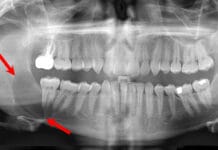Tooth decay is no stranger to the dental professional. In fact, it isn’t a stranger to most! According to a study done by the CDC, 1 out of every five children aged 5-11 and 1 of 7 adolescents aged 12-19 have dental decay.1
However, children are not the only ones who suffer from dental decay. According to the CDC, 91% of U.S. adults aged 20-64 had dental caries in permanent teeth in 2011-2012.1 As a dental professional this is astounding considering the components that exist to help prevent dental decay. However, without utilizing prevention components, these resources are null and void. One of the greatest of these preventions is the sealant.
The human dentition is continuously covered with a thin layer of bacteria-packed biofilm called plaque. This plaque binds with acids upon eating and drinking attacking the tooth’s surface. Brushing and flossing helps to eliminate plaque, however, because of the anatomy of the permanent molar, the deep pit and fissures on the occlusal surfaces can be difficult to thoroughly clean. Enter sealants. Applying a thin, flowable plastic-like substance to these hard to access areas will “seal” off these crevices and assist in preventing dental decay.
In the mid-1960s, Drs. Michael Buonocore and E. I. Cueto introduced the first commercial sealant.2 The dental sealant has been stated as one of the most significant advances in modern dentistry. This simple, yet innovative, idea acts as a barrier preventing acid and bacteria from resting in pit and fissures destroying enamel.
Sealants have evolved over the years making application easier for the clinician and the patient. While children benefit the most, adults can also reap the benefits from sealant application. It is never too late to protect a chewing surface that is free from dental decay. In fact, doing so will only save the patient time and money in the future, as the tooth will likely remain free from decay. Good news – most dental insurance companies pay for this procedure!
As soon as the 6-year molars fully erupt in the dental cavity, it is advised sealants are placed. This process should be repeated when 12-year molars erupt. Cochrane reviewed 38 studies involving 7,924 young people (aged 5-16 years) which evaluated the effectiveness of sealant placement. These studies revealed if 40% of posterior teeth develop decay over 24 months, using sealant reduces this to 6%.3 Sealants have even been used by some dentists to stop very early stages of tooth decay from going on to form a cavity.
Some dental circles have brought up rising concerns of the exposure to bisphenol A (BPA) from dental sealants a few hours after placement. Studies report materials that contain small, trace amounts of BPA are not a health concern due to the low levels reported (0.0001%). In fact, according to the American Dental Association (ADA), breathing air exposes people to 100 times more BPA (0.13%) than dental sealants.4 Because of this concern, many companies now offer BPA-free dental sealants.
Dental sealants have evolved tremendously over the decades. Initially, dental sealants were “self-curing,” setting up quickly and reducing the time for manipulation. Most sealants today require a curing light after placement. One of the biggest struggles in sealant placement is maintaining a dry field. From personal experience, it is mentally taxing when trying to place a sealant on a child who is far from cooperative. I can count endless times I have had to repeat the process due to moisture entering the field. Companies have now developed products that utilize wet-bond technology simplifying the process. This product is essential especially if you aren’t afforded the privilege of an assistant.
Sealants are one of the most effective interventions available for prevention of tooth decay, according to Dr. Alonso Carrasco-Labra, Director of the American Dental Association’s Center for Evidence-Based Dentistry.5 Parents should be asking for them, and dental professionals should be suggesting them. Such a simple concept can go such a long way. The way I look at it is, you either seal them, or you drill them.
Before you leave, check out the Today’s RDH self-study CE courses. All courses are peer-reviewed and non-sponsored to focus solely on high-quality education. Click here now.
Listen to the Today’s RDH Dental Hygiene Podcast Below:
SEE ALSO: Why Caries Detection is More than Just Looking for “Stickiness”
DON’T MISS: The Use of Amelogenin in Dental Caries Prevention and Treatment
References
- Dye BA, Xianfen L, Beltrán-Aguilar ED. Selected Oral Health Indicators in the United States 2005–2008. NCHS Data Brief, no. 96. Hyattsville, MD: National Center for Health Statistics, Centers for Disease Control and Prevention; 2012.
- Spielman, Andrew I. “Technology in Dentistry, Through the Ages.” Technology in Dentistry Through the Ages. Retrieved from http://dental.nyu.edu/aboutus/history-of-nyucd/technology-in-dentistry-through-the-ages.html.
- Ahovuo-Saloranta, A, et al. “Cochrane.” Effect of Cutting down the Fat We Eat on Body Weight | Cochrane, 31 July 2017. Retrieved from www.cochrane.org/CD001830/ORAL_sealants-preventing-tooth-decay-permanent-teeth.
- Center for Scientific Information, ADA Science Institute. “Dental Sealants.” Home – American Dental Association, 19 Oct. 2016. Retrieved from www.ada.org/en/member-center/oral-health-topics/dental-sealants.
- Mark, Anita M. “Dental Sealants.” Aug 2016. Retrieved from https://jada.ada.org/article/S0002-8177(16)30444-5/fulltext.












